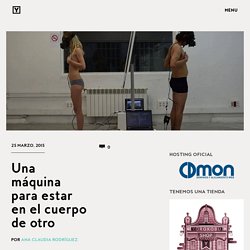

HARMONY, Japan Pavilion, Expo Milano 2015. TeamLab, 2015, Interactive Digital Installation, Sound: Hideaki Takahashi Rice fields form the background of the origin of Japan’s food culture.

They were grown and developed in areas at different height levels, mid to high river basins. This is reflected in the terraced rice-fields that are so characteristic of Japan, a country surrounded by mountains and the sea. The process was made possible thanks to the beautiful harmony that has existed between humans and nature. In order to show the fact that paddy fields have prospered in places with differing heights, as well as through the harmonious relationship between humans and nature, the space of the exhibition room has been filled with screens resembling ears of rice.
This interactive art installation creates a space where visitors look as if they are wading their way through the rice fields. Artículos etiquetados "proyección por mapeo" Una máquina para estar en el cuerpo de otro. Por Ana Claudia Rodríguez ara empezar, una palabra rara: «solipsismo».

O la creencia de que la única certeza del individuo es la existencia de su propia mente. A partir de esta premisa, postula el solipsismo que todas las cosas (los objetos, las tendencias, las personas de su universo) son solo emanaciones que surgen del interior. Enfrentados a este ombliguismo, Be Another Lab, un grupo de investigadores afincados en Barcelona, propone una alternativa: La Máquina de Ser Otro, un artilugio con el que, dicen, puede verse el mundo con ojos ajenos y adoptar en carne propia cualquier identidad. Imaginad el transformismo: de repente el color de vuestra piel es distinto al habitual. ¿Es ciencia ficción? En la práctica el procedimiento es sencillo. Art TV Station for Video Art, Film & Music.
He probado la realidad virtual del HTC Vive, y ahora ya no quiero volver. Chloé Rutzerveld: Edible Growth, cultivo de impresión 3D. Imágenes cortesía: Chloé Rutzerveld La diseñadora holandesa dedicada a la investigación y el desarrollo de conceptos en torno al food design Chloé Rutzerveld ha desarrollado el proyecto Edible Growth o ”cultivo comestible”, un ejemplo de como un producto alimenticio puede ser un puente entre las nuevas tecnologías y las auténticas y tradicionales prácticas de cultivo de alimentos.

MWC 2015 : les 5 nouveautés les plus spectaculaires. 01net le 07/03/15 à 09h56 Le Mobile World Congress 2015 vient de fermer ses portes, et il faut bien avouer que la prestation des grands acteurs du secteur à Barcelone n’a pas été à la hauteur de nos espérances.

En dehors de Samsung qui a écrasé l’évènement avec ses Galaxy S6 et S6 Edge... Descripción de los diferentes sistemas operativos móviles. Hace unos meses hicimos un repaso a los distintos sistemas operativos para equipos de sobremesa existentes.

Hoy hacemos lo mismo con los sistemas operativos para dispositivos móviles Hace ya mucho tiempo que la guerra de los fabricantes de los teléfonos móviles pasó del hardware al software. Adelin Schweitzer : Les prolongements technologiques de l’art. Mag - magazine international de l’art numérique. Studio Markus Kison, Berlin. Design + research. Burble Note: The two projects, Sky Ear and Burble, have only one thing in common: the use of custom-designed electronics and LED lights inside of balloons.

Technically, conceptually and practically, the two projects are otherwise completely different. The Burble has appeared in various incarnations over its history: Open Burble, Burble London, Burble Dubai, Burble Phish/Mini Burble, Control.Burble.Remote. Open Burble The first Burble ever, launched at the open ceremonies of the Singapore Biennale 2006, was known as Open Burble and consisted of a 15 storey structure designed, assembled and controlled by members of the public. Read more here: Open Burble. Photos from the Singapore Biennale, 2006, by Engkiat Tan and others Burble London Burble London came next. Read more here: Burble London. Video by Mariko Montpetit Burble London, Holland Park, 2007 (photos by Wang Wei) Burble Dubai Phish Burble a.k.a.
Control.Burble.Remote [ back to projects ] Electroland — Pulse. Networked Art: 10 projects using real time data- Postscapes. These 10 networked art projects show the many ways that using real-time data like weather, pollution sensors, wave monitoring and all the other outputs that are streaming around us can be used to visualize and engage our environment in new ways. 1) eCLOUD Project: Image: spencer lowell and www.ecloudproject.comInstalled in the San Jose International Airport eCLOUD is a permanent art work by Aaron Koblin, Nik Hafermaas and Dan Goods.

It is constructed from polycarbonate tiles that fade in between transparent and opaque states and are controlled by real time weather from NOAA from locations around the world. This data is used to create a simulation representing weather from any of the international locations by turning the individual tiles on and off in a certain pattern. The simulation is visualized within the cloud sculpture as well as on a dynamic display placed at eye level in the terminal.View the process, technology and additional details about the project here.2) Living Light: Media Art Design [ Dominique Moulon ] Untitled. Le Magazine des nouvelles technologies et des tests produits high-tech - Le Monde Numérique.